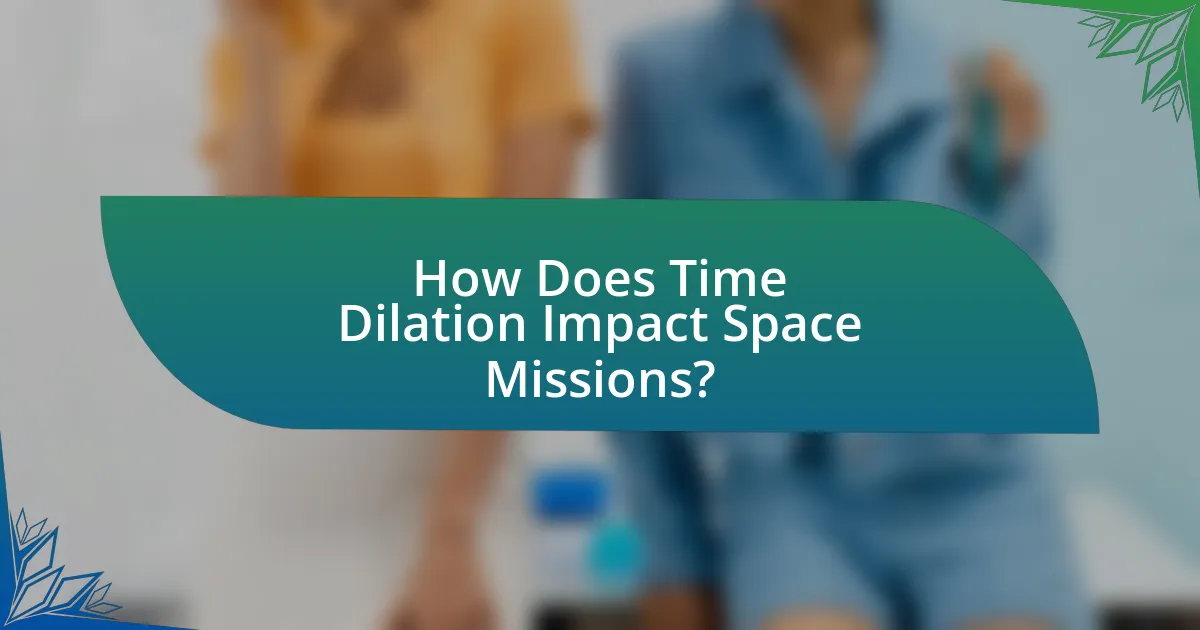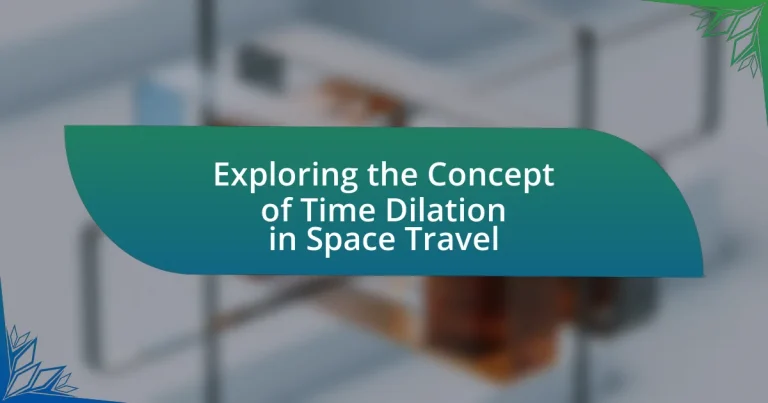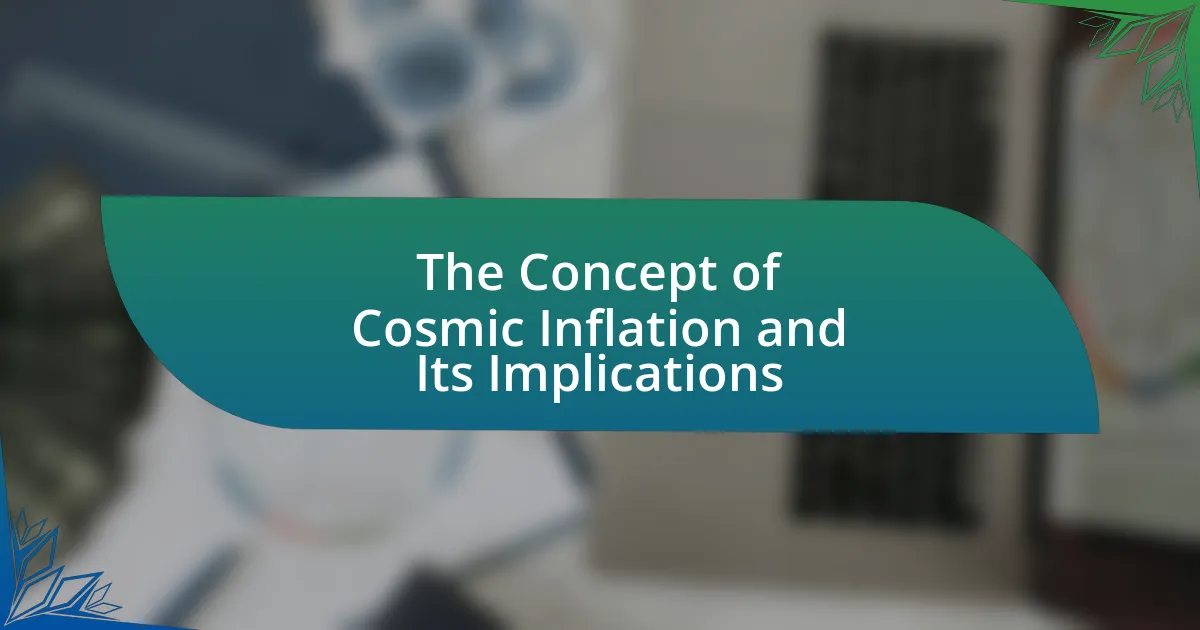Time dilation is a phenomenon in space travel where time passes at different rates for observers in varying gravitational fields or relative velocities, as described by Einstein’s theory of relativity. This article explores the definitions, principles, and implications of time dilation, including its effects on astronauts during high-speed travel and long missions. It discusses the significance of time dilation for mission planning, communication with Earth, and the technological advancements needed to study this concept further. Additionally, it highlights real-world examples, such as the Hafele-Keating experiment and GPS satellite technology, illustrating the practical applications of time dilation in space exploration.

What is Time Dilation in the Context of Space Travel?
Time dilation in the context of space travel refers to the phenomenon where time passes at different rates for observers in different gravitational fields or relative velocities. According to Einstein’s theory of relativity, as an object approaches the speed of light, time for that object slows down relative to an observer at rest. This effect has been confirmed through experiments, such as those involving atomic clocks on fast-moving jets, which showed that time measured on the moving clocks was less than that on stationary clocks. Thus, astronauts traveling at high speeds in space would age more slowly compared to people on Earth, illustrating the practical implications of time dilation in space travel.
How is Time Dilation Defined in Physics?
Time dilation in physics is defined as the phenomenon where time passes at different rates for observers in different frames of reference, particularly when one is moving at a significant fraction of the speed of light or is in a strong gravitational field. This concept is rooted in Einstein’s theory of relativity, which posits that time is not absolute but relative to the observer’s state of motion. For example, an astronaut traveling at high speeds in space will experience less passage of time compared to someone on Earth, a fact confirmed by experiments involving atomic clocks flown on aircraft, which showed measurable differences in elapsed time.
What are the key principles behind Time Dilation?
Time dilation is primarily governed by the principles of relativity, specifically Einstein’s theory of special relativity. According to this theory, time is experienced differently for observers in different frames of reference, particularly when one is moving at a significant fraction of the speed of light. This effect is quantified by the Lorentz factor, which shows that as an object’s speed approaches the speed of light, time for that object slows down relative to a stationary observer.
Additionally, gravitational time dilation, a concept from general relativity, states that time passes more slowly in stronger gravitational fields. This has been confirmed through experiments, such as those involving atomic clocks placed at different altitudes, where clocks at higher altitudes (weaker gravity) tick faster than those at lower altitudes (stronger gravity). These principles illustrate that time is not a constant, but rather a variable influenced by speed and gravity.
How does Einstein’s Theory of Relativity explain Time Dilation?
Einstein’s Theory of Relativity explains time dilation by stating that time passes at different rates for observers in different frames of reference, particularly when one is moving at a significant fraction of the speed of light. According to the theory, as an object approaches the speed of light, time for that object slows down relative to a stationary observer. This phenomenon is mathematically described by the Lorentz transformation equations, which show that time intervals are affected by relative velocity. Experimental evidence supporting this includes observations of atomic clocks on fast-moving jets, which demonstrate that time measured on the jets is less than that measured on the ground, confirming the predictions of time dilation as outlined in Einstein’s theory.
Why is Time Dilation Significant for Space Travel?
Time dilation is significant for space travel because it affects the perception of time for astronauts traveling at high velocities relative to Earth. According to Einstein’s theory of relativity, as an object approaches the speed of light, time for that object slows down compared to a stationary observer. This phenomenon has been confirmed through experiments, such as those involving atomic clocks on fast-moving jets, which showed that time elapsed more slowly for the clocks in motion compared to those on the ground. Consequently, for long-duration space missions, time dilation must be considered in mission planning and communication, as it impacts the synchronization of time between astronauts and people on Earth.
What implications does Time Dilation have for astronauts on long missions?
Time dilation implies that astronauts on long missions experience time at a different rate compared to people on Earth. This phenomenon, predicted by Einstein’s theory of relativity, occurs due to the high speeds at which spacecraft travel and the effects of gravity in space. For instance, astronauts aboard the International Space Station, traveling at approximately 28,000 kilometers per hour, age slightly slower than individuals on Earth, with calculations showing a difference of about 0.01 seconds for every six months spent in orbit. This discrepancy can lead to significant variations in aging and time perception for astronauts on extended missions, potentially affecting their psychological well-being and mission planning.
How does Time Dilation affect communication with Earth during space travel?
Time dilation affects communication with Earth during space travel by causing time discrepancies between astronauts in space and people on Earth. As astronauts travel at speeds approaching the speed of light, time for them slows down relative to Earth, leading to delays in communication. For example, if an astronaut experiences one year of travel time, several years may pass on Earth, complicating real-time communication and decision-making. This phenomenon is a consequence of Einstein’s theory of relativity, which has been validated through experiments such as the Hafele-Keating experiment, where atomic clocks on airplanes showed measurable differences in elapsed time compared to stationary clocks on the ground.
What are the Different Types of Time Dilation?
There are two primary types of time dilation: gravitational time dilation and relative velocity time dilation. Gravitational time dilation occurs due to the influence of gravity on the passage of time, as described by Einstein’s General Theory of Relativity; for example, time runs slower in stronger gravitational fields, such as near a massive object like a planet or star. Relative velocity time dilation, on the other hand, arises from the effects of traveling at high speeds, as outlined in Einstein’s Special Theory of Relativity; specifically, as an object approaches the speed of light, time appears to pass more slowly for that object compared to a stationary observer. These concepts have been experimentally validated through observations such as the behavior of atomic clocks on satellites, which demonstrate measurable differences in time experienced due to both gravitational fields and relative motion.
What is Gravitational Time Dilation?
Gravitational time dilation is the phenomenon where time passes at different rates in regions of varying gravitational potential. According to Einstein’s theory of general relativity, the stronger the gravitational field, the slower time moves relative to a weaker gravitational field. For example, time runs slightly faster on a satellite in orbit compared to time on Earth due to the difference in gravitational strength. This effect has been confirmed through experiments, such as those involving atomic clocks placed at different altitudes, which demonstrated measurable differences in elapsed time.
What is Relative Velocity Time Dilation?
Relative velocity time dilation is a phenomenon predicted by Einstein’s theory of relativity, where time is experienced differently for observers in relative motion. Specifically, as an object’s velocity approaches the speed of light, time for that object slows down relative to a stationary observer. This effect has been confirmed through experiments, such as those involving atomic clocks on fast-moving jets, which show that time passes more slowly for the clocks in motion compared to those at rest.

How Does Time Dilation Impact Space Missions?
Time dilation significantly impacts space missions by affecting the perceived passage of time for astronauts traveling at high velocities or in strong gravitational fields. According to Einstein’s theory of relativity, time moves slower for objects in motion compared to those at rest; this effect becomes pronounced at speeds approaching the speed of light. For instance, the twin paradox illustrates that an astronaut traveling on a spacecraft at relativistic speeds would age more slowly than their twin remaining on Earth. This phenomenon has practical implications for long-duration missions, such as those to Mars, where time dilation could result in discrepancies in mission timelines and communication with Earth. NASA’s experiments with atomic clocks on satellites have confirmed that time dilation occurs, with clocks on GPS satellites running faster than those on the ground due to their speed and altitude, demonstrating the real-world effects of time dilation on technology used in space missions.
What are the Real-World Examples of Time Dilation in Space Travel?
Real-world examples of time dilation in space travel include the observations made during the twin paradox thought experiment and the precise measurements taken by atomic clocks on spacecraft. In the twin paradox, one twin traveling at relativistic speeds experiences less passage of time compared to the twin remaining on Earth. This concept is supported by experiments involving atomic clocks flown on jets, which showed that the clocks on the moving jets recorded less elapsed time than those on the ground, confirming predictions made by Einstein’s theory of relativity. Additionally, the Global Positioning System (GPS) satellites account for time dilation effects due to their speed and altitude, requiring adjustments to maintain accurate positioning data.
How did the Hafele-Keating experiment demonstrate Time Dilation?
The Hafele-Keating experiment demonstrated time dilation by comparing the time experienced by atomic clocks flown on commercial airliners around the world to those kept stationary on the ground. In 1971, physicists Joseph Hafele and Richard Keating flew four atomic clocks on two planes, one traveling eastward and the other westward, around the globe. Upon their return, the clocks on the planes showed a difference in elapsed time compared to the clocks on the ground, confirming predictions made by Einstein’s theory of relativity. Specifically, the eastward clock experienced less time than the stationary clocks, while the westward clock experienced more time, illustrating the effects of both velocity and gravitational potential on time perception.
What role does Time Dilation play in GPS satellite technology?
Time dilation is crucial for the accuracy of GPS satellite technology, as it affects the timekeeping of satellites relative to observers on Earth. GPS satellites orbit at high speeds and experience weaker gravitational fields compared to those on the Earth’s surface, leading to time running faster for the satellites by approximately 38 microseconds per day. This discrepancy must be corrected; otherwise, GPS positioning would accumulate errors of about 10 kilometers each day. The theory of relativity, proposed by Albert Einstein, provides the framework for understanding these effects, confirming that both special and general relativity contribute to the necessary adjustments in satellite clocks to ensure precise location data.
How Can Astronauts Prepare for Time Dilation Effects?
Astronauts can prepare for time dilation effects by understanding the principles of relativity and incorporating them into mission planning. This preparation involves training that emphasizes the impact of high-speed travel on time perception, as described by Einstein’s theory of relativity, which states that time slows down for objects moving at significant fractions of the speed of light. For instance, astronauts on missions to the International Space Station experience time dilation, where they age slightly less than people on Earth due to their orbital speed. NASA’s training programs include simulations and educational resources that help astronauts grasp these concepts, ensuring they are mentally prepared for the differences in time experienced during space travel.
What training do astronauts undergo to understand Time Dilation?
Astronauts undergo specialized training that includes theoretical education and practical simulations to understand time dilation. This training encompasses physics lessons focused on Einstein’s theory of relativity, which explains how time can be affected by speed and gravity. Additionally, astronauts participate in simulations that illustrate the effects of time dilation during space travel, helping them grasp the concept through real-world applications. This comprehensive approach ensures that astronauts are well-prepared to comprehend the implications of time dilation on their missions, particularly during high-speed travel in space.
How can mission planners account for Time Dilation in mission design?
Mission planners can account for time dilation in mission design by incorporating relativistic effects into their calculations for spacecraft trajectories and mission timelines. This involves using the equations of special relativity, particularly the Lorentz factor, to adjust the perceived passage of time for astronauts traveling at significant fractions of the speed of light. For example, when planning missions to distant stars, planners must calculate how time will differ for the crew compared to observers on Earth, ensuring that mission schedules align with the expected time experienced by both parties. Historical missions, such as the GPS satellite system, have demonstrated the necessity of accounting for time dilation, as satellites experience both gravitational and velocity-based time dilation, requiring adjustments to maintain accuracy.

What Future Research is Needed on Time Dilation in Space Travel?
Future research on time dilation in space travel is needed to better understand its effects on human physiology and technology during long-duration missions. Specifically, studies should focus on the biological impacts of time dilation on astronauts, including cognitive function and aging processes, as evidenced by the twin study involving astronaut Scott Kelly, which highlighted genetic and epigenetic changes after a year in space. Additionally, research should investigate the implications of time dilation for navigation and communication systems in deep space travel, as current models may not fully account for relativistic effects. Enhanced simulations and experimental data from high-speed travel scenarios, such as those proposed for future missions to Mars or beyond, will provide critical insights into these phenomena.
What are the Current Limitations in Understanding Time Dilation?
Current limitations in understanding time dilation include the challenges in accurately measuring the effects of time dilation in practical scenarios and the complexities of integrating quantum mechanics with general relativity. Experimental verification of time dilation, such as through atomic clocks on fast-moving aircraft, shows time discrepancies, but these experiments are limited in scale and scope. Additionally, the theoretical models of time dilation do not fully account for all relativistic effects in extreme gravitational fields or at quantum levels, leading to gaps in our comprehensive understanding. These limitations hinder the application of time dilation concepts in advanced space travel scenarios, where precise calculations are crucial for mission planning and execution.
What technological advancements are required to study Time Dilation further?
To study time dilation further, advancements in high-precision atomic clocks and particle accelerators are essential. High-precision atomic clocks, such as optical lattice clocks, can measure time with unprecedented accuracy, allowing scientists to observe the effects of time dilation in varying gravitational fields and relative velocities. Particle accelerators, like the Large Hadron Collider, enable researchers to accelerate particles to speeds close to the speed of light, providing empirical data on relativistic effects, including time dilation. These technologies have already demonstrated their capabilities; for instance, experiments with atomic clocks on airplanes have confirmed time dilation predictions by showing that clocks at higher altitudes tick faster than those on the ground, aligning with Einstein’s theory of relativity.
How can future missions better utilize knowledge of Time Dilation?
Future missions can better utilize knowledge of time dilation by incorporating precise calculations of relativistic effects into mission planning and navigation systems. For instance, missions traveling at significant fractions of the speed of light, such as those proposed for interstellar travel, must account for the time experienced by astronauts versus that on Earth to ensure accurate communication and mission timelines. Historical data from experiments, such as those involving atomic clocks on fast-moving jets, have demonstrated that time dilation is a measurable phenomenon, with clocks on the jets showing a difference compared to stationary clocks. By applying these principles, future missions can optimize their schedules, enhance safety protocols, and improve the overall efficiency of long-duration space travel.
What Practical Tips Can Be Applied Regarding Time Dilation in Space Travel?
To mitigate the effects of time dilation in space travel, astronauts can employ strategies such as traveling at lower speeds relative to the speed of light and planning missions to minimize the duration of high-speed travel. For instance, according to Einstein’s theory of relativity, as an object’s speed approaches the speed of light, time for that object slows down relative to a stationary observer. Therefore, maintaining a speed significantly lower than light speed can reduce the extent of time dilation experienced. Additionally, mission planners can schedule shorter trips or utilize gravitational assists to optimize travel time, thereby reducing the impact of time dilation on the crew.
How can space agencies effectively communicate Time Dilation concepts to the public?
Space agencies can effectively communicate Time Dilation concepts to the public by utilizing clear visual aids, relatable analogies, and interactive educational programs. Visual aids, such as infographics and videos, can illustrate the effects of Time Dilation in a straightforward manner, making complex scientific principles more accessible. For example, NASA has used animations to depict how time behaves differently for astronauts traveling at high speeds compared to people on Earth. Relatable analogies, such as comparing Time Dilation to the experience of traveling in a fast-moving vehicle, can help the public grasp the concept more intuitively. Additionally, interactive educational programs, like workshops and online simulations, allow individuals to engage with the concept hands-on, reinforcing their understanding through practical experience. These methods have been shown to enhance public comprehension of scientific concepts, as evidenced by educational studies that highlight the effectiveness of visual and experiential learning in science communication.
What best practices should be followed in mission planning to mitigate Time Dilation effects?
To mitigate Time Dilation effects in mission planning, spacecraft should be designed for optimal velocity and trajectory to minimize relativistic speeds. By planning missions that maintain velocities significantly lower than the speed of light, the impact of Time Dilation can be reduced. For instance, missions to Mars typically operate at speeds around 24,600 kilometers per hour, which is well below relativistic speeds, thus minimizing Time Dilation effects. Additionally, mission planners should incorporate time synchronization protocols to ensure accurate timekeeping between Earth and the spacecraft, as demonstrated in the Global Positioning System (GPS), where adjustments are made for relativistic effects to maintain precision. These practices collectively help in managing the implications of Time Dilation during space travel.




